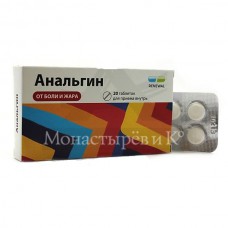Expiration date: 09/2026
Description:
The drugs - analgesic.
Composition:
Active ingredient: dipyrone (Metamizole) 0, 5 g,
Indications for use:
Febrile syndrome (infectious-inflammatory diseases, insect bites and stings - mosquitoes, bees, gadflies, etc., post-transfusion complications)
Pain syndrome (weak and moderate symptoms): including neuralgia, myalgia, arthralgia, biliary colic, intestinal colic, renal colic, trauma, burns, decompression sickness, shingles, orchitis, sciatica, myositis, postoperative pain, headache, toothache, algomenorrhea.
Contraindications:
Hypersensitivity to the pyrazolone derivative (phenylbutazone, tribuson), bronchial asthma, diseases accompanied by bronchospasm, "aspirin asthma",
oppression blood (agranulocytosis, neutropenia, leukopenia), severe liver or kidney problems, blood diseases, hereditary hemolytic anemia associated with a deficit glukozo-6-fosfatdegidrogenaza, pregnancy (especially in I trimester and in recent 6 ned), lactation. With care — infancy (up to 3 months).
Pharmacodynamics:
Metamizole is a pyrazolone derivative. It has analgesic, antipyretic and weak anti-inflammatory effects, the mechanism of which is associated with the inhibition of synthesis of PG. Pharmacological effect develops in 20-40 minutes after ingestion and reaches its maximum after 2 hours.
Pharmacokinetics:
When ingestion rapidly and completely absorbed. In the bowel wall hydrolyses education active metabolite is not changed Metamizole in blood is missing (only after the on/in the introduction of a small concentration found in plasma). The level of binding of the active metabolite to proteins is 50-60%. Destroyed in the liver. Excretion is through the kidneys.
The action develops through 20-40 minutes and reaches its maximum after 2 hours.
Side effects:
Allergic reactions: skin rash, Quincke's edema, rarely — anaphylactic shock, toxic epidermal necrolysis (Lyell's syndrome), in rare cases, Stevens — Johnson syndrome,
Prolonged use may cause leukopenia, thrombocytopenia, agranulocytosis,
The tendency to bronchospasm may provoke attack, decreased blood pressure,
Possible impairment of renal function, oliguria, anuria, proteinuria, interstitial nephritis, urine staining in red due to separation of the metabolite
The method of preparation or use:
Inside, adult — 1 table. 2-3 times a day after meals. The maximum single dose — 1 g (2 table.), daily — 3 g (6 table.). During long-term (more than weeks) use of the drug needed to be monitored picture peripheral blood and functional state of the liver.
Children appoint 5 to 10 mg/kg of body weight 3-4 times a day for no more than 3 days (pre-chopped the pill).
Not apply (without consulting physician) for more than 3 days in the appointment as a febrifuge, and more than 5 days at appointment as an anesthetic.
Storage conditions:
In a dry, dark place


